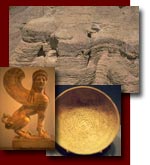| Site Map | Contacts | Links | Newsletter | |
Biblical Archaeology:
Where is the Ark of the Covenant?
Does Sheshonq I take the Ark to Tanis?
Some think that the Ark of the Covenant was taken to Egypt by Shishak when he attacked Jerusalem. I Kings 14:25-26 says, "In the fifth year of King Rehoboam, Shishak king of Egypt attacked Jerusalem. He carried off treasures of the temple of the Lord and the treasures of the royal palace. He took everything, including all the gold shields Solomon had made" (NIV). II Chronicles 12:2-4,9 says, "Because they had been unfaithful to the Lord, Shishak king of Egypt attacked Jerusalem in the fifth year of King Rehoboam. With twelve hundred chariots and sixty thousand horsemen and the innumerable troop of Libyans, Sukkites and Cushites that came with him from Egypt, he captured fortified cities of Judah and came as far as Jerusalem...When Shishak king of Egypt attacked Jerusalem, he carried off the treasures of the temple of the Lord and the treasures of the royal palace. He took everything, including the gold shields Solomon had made" (NIV).
The Hebrew name Shishak matches the Egyptian name of Sheshonq I in Egyptian history. Sheshonq is the founder of the 22nd Dynasty of Egypt. Sheshonq I ruled from 945-924 BC. He was from a Libyan tribe who became commander-in-chief, then King. He was a strong leader who reunited Egypt. 2 Chronicles 12:3-4 says, "With 1200 chariots and 60,000 horsemen and the innumerable troops of Libyans, Sukkites (mercenary Libyan soldiers) and Cushites (Upper Egypt) that came with him from Egypt, he captured the fortified cities of Judah and came as far as Jerusalem" (NIV). Note the many troops from Libya. Thutmose III nor Rameses II would not have had an army composed of mainly outsiders, but Egyptians. There are inscriptions of Sheshonq's campaign into Palestine on the wall of the temple of Amon in Karnak. ANET, 263; ANEP, 349; ANE 1, fig.94. It says that Sheshonq I went as far as Megiddo where a victory stele was erected. ANET 242-3 has a list the the cities he captured. For more information on the list see Handbook for the Study of Egyptian Topographical Lists Relating to Western Asia by J. Simons, Leiden 1937 (pp.90-101,178-186: see also Breasted, Ancient Records of Egypt, Vol. 4, paragraph 709). For more information on Sheshonq see What evidence has been found of the Egyptian king, Shishak?
Sheshonq I established Tanis as the capitol of Egypt. If indeed all the treasures of the Temple were taken by Sheshonq I, then the Ark was taken back to Tanis. Part of the loot was usually given to the temples in Egypt especially the god the pharaoh worshipped in thanks for their great military victory. There is a fragmentary inscription of Sheshonq delivering tribute from Palestine to the god Amon (See Breasted, Vol.4, paragraph 723). Sometimes they would melt down the metals and remake what they wanted. So the Ark of the Covenant may be somewhere in Egypt. In the movie Raiders of the Lost Ark Indiana Jones looks for the Ark in Tanis. However, other legends say that the Jews hid the Ark, and did not give it to Sheshonq I.
One legend says that Solomon had a son named Menelik by the Queen of Sheba who took the Ark back to Ethiopia. Supposedly, King Solomon had this son by the Queen of Sheba when she came to visit Solomon (I Kings 10:1-13; 2 Chronicles 9:1-12). When he grew up Menelik returned to Jerusalem for a copy of the Ark of the Covenant which Solomon gave to him. But Menelik secretly switched the real Ark with the replica. Menelik took the real Ark back to Ethiopia. Traditionally, Sheba is located in Saudi Arabia not Ethiopia (more details about this below).
The Ark is mentioned later in the days of Josiah. 2 Chronicles 35:3 states, "He (Josiah) said to the Levites, who instructed all Israel and who had been consecrated to the Lord: 'Put the sacred ark in the temple that Solomon son of David king of Israel built. It is not to be carried about on your shoulders" (NIV). The Book of the Law was found by Hilkiah the priest in the Temple. Josiah sets up reforms.
Does Nebuchadnezzar take the Ark to Babylon?
Some think that the Ark of the Covenant was taken by Nebuchadnezzar to Babylon when he captured and destroyed Jerusalem in 586 BC. 2 Kings 25:13-15 says, "The Babylonians broke up the bronze pillars, the movable stands and the bronze Sea that were at the temple of the Lord and they carried the bronze to Babylon. They also took away pots, shovels, wick trimmers, dishes and all the bronze articles used in the temple service. The commander of the imperial guard took away the censers and sprinkling blows-all that were made of pure gold or silver " (NIV; see also Jeremiah 52:17-22). However, notice that there is no mention of the Ark of the Covenant. The parallel account given in 2 Chronicles 36:17-19 probably written by Ezra says, "God handed all of them over to Nebuchadnezzar. He carried to Babylon all the articles from the temple of God, both large and small, and the treasures of the Lord's temple and the treasures of the king and his officials. They set fire to God's temple and broke down the wall of Jerusalem; they burned all the places and destroyed everything of value there" (NIV).
The Fourth Book of Ezra 10:19-22 states, "So I spoke again to her, and said, 'Do not say that, but let yourself be persuaded because of the troubles of Zion, and be consoled because of the sorrow of Jerusalem. For you see that our sanctuary had been laid waste, our altar thrown down, our temple destroyed; our harp had been laid low, our song has been silenced, and our rejoicing had been ended; the light of our lampstand had been put out, the ark of our covenant has been plundered, our holy things have been polluted, and the name by which we are called has been profaned; our free men have suffered abuse, our priests have been burned to death, our Levites have gone into captivity" (Charlesworth 1983, 546-7). According to the Fourth Book of Ezra the Ark of the Covenant was taken to Babylon.
Did Jeremiah Hide the Ark in a Cave?
In 2 Maccabees 2:4-6 Jeremiah is told to hide the Ark in a cave in Mt. Nebo. 2 Maccabees 2:4-6 says, "It was also contained in the same writing, how the prophet (Jeremiah), being warned by God, commanded that the tabernacle and the ark should accompany him, till he came forth to the mountain where Moses went up and saw the inheritance of God (Mt. Nebo). And when Jeremias came thither he found a hollow cave: and he carried in thither the tabernacle and the ark and the altar of incense and so stopped the door. Then some of them that followed him came up to mark the: but they could not find it. And when Jeremias perceived it he blamed them saying: The place shall be unknown till God gather together to congregation of the people and receive them to mercy" (Douay).
According to 2 Baruch 6:5-9 an angel came down from heaven into the Holy of Holies and took "the veil, the holy ephod, the mercy seat, the two tables, the holy raiment of the priest, the altar of incense, the forty-eight precious stones with which the priests were clothed, and all the holy vessels of the tabernacle" (Charlesworth 1983, 623). These are stories that the Ark was hidden.
After Cyrus the Great conquered Babylon, he issued a decree for the temple at Jerusalem to be rebuilt in 538 BC. The Jews could now return to Jerusalem. Ezra 1:7 says, "Moreover, King Cyrus brought out the articles belonging to the temple of the LORD, which Nebuchadnezzar had carried away from Jerusalem and had placed in the temple of his god" (NIV note: "It was the custom for conquerors to carry off the images of the gods of conquered cities.). The inventory in Ezra 1:9-11 lists gold and silver dishes, silver pans, gold and silver bowls, and other articles for a total of 5,400 items. The Ark of the Covenant is not specifically listed.
Did Antiochus Epiphanes take the Ark to Syria?
I Maccabees 1:21-24, 57 states, "And after Antiochus had ravaged Egypt in the hundred and forty-third year, he returned and went up against Isreal. And he went up to Jerusalem with a great multitude. And he proudly entered into the sanctuary and took away the golden altar and the candlestick of light and all the vessels thereof and the table of proposition and the pouring vessels and the vials and the little mortars of gold and the veil and the crowns and the golden ornament that was before the temple: and he broke them all in pieces. And he took the silver and gold, and the precious vessels: and he took the hidden treasures which he found. And when he had taken all away he departed into his own country...On the fifteenth day of the month Casleu, in the hundred and forty-fifth year, king Antiochus set up the abominable idol of desolation upon the altar of God" (Douay). It seems that the furniture of the Temple was broken into pieces, and then carried back to Syria. There is no mention of the Ark of the Covenant.
Did Titus take the Ark to Rome?
The Romans captured the city of Jerusalem in 70 AD. Titus took the vessels from the Temple and brought them to Rome. There is a carving of the lampstand or Menorah, the Table of Shewbread, and ritual trumpets on the Triumphant Arch of Titus in Rome. There is no carving of the Ark of the Covenant. Josephus in the Jewish War writes, "Most of the spoils that were carried were heaped up indiscriminately, but more prominent than all the rest were those captured in the Temple at Jerusalem-a golden table weighing several hundredweight, and a lampstand, similarly made of gold but differently constructed from those we normally use...After these was carried the Jewish Law, the last of the spoils...Vespasian made up his mind to build a temple of Peace...There too he laid up the golden vessels from the Temple of the Jews, for he prided himself on them; but their Law and the crimson curtains of the Inner Sanctuary he ordered to be deposited in the Palace for safe keeping" (Book VII, Chp.V, 5-6; Translation by G.A. Williamson, New York: Dorset, 1959, 385-6).
About these temple vessels in Rome G. A. Williamson comments, "They were seized by the Vandals and taken to North Africa in 455, recovered and removed to Constantinople, the capital of the eastern empire in 534, and then, reputedly, sent to a church in Jerusalem, where they remained till the seventh century. They disappeared at an unknown later date" (Ibid, 456). With the conquest of Islam the vessels could have been taken any where under their control.
In Josephus' description of the Temple, there is no mention of the Ark of the Covenant. The Holy of Holies was empty. Josephus states, "The innermost chamber measured 30 feet and was similarly separated by a curtain from the outer part. Nothing at all was kept in it; it was unapproachable, inviolable, and invisible to all, and was called the Holy of Holies" (Book V, Chp. V, 5; Williamson, 304). It seems that there was no Ark of the Covenant in the Second Temple.
Other Claims about the Ark!
Certain Rabbis claim to have seen the Ark in a tunnel under the Temple ground in Jerusalem. The Israeli government sealed the entrance with cement because of protests from the Arabs, because it was near the Dome of the Rock. There is no proof that the Ark is there.
Ron Wyatt claims to have found the Ark in a tunnel in a quarry in Mt. Moriah where Christ was crucified, but there is no proof. He claims to have scraped the blood of Jesus off the mercy seat which had dripped down through a crack in the rocks right under where Christ was crucified. He claims the blood has only 24 chromosomes instead of the normal 46, but where are the laboratory tests on the blood? He has no proof. His web site is at http://www.wyattarchaeology.com/ark.htm.
Some claim the ark is in a church in Axum, Ethiopia. This view has been popularized by Graham Hancock's book The Sign and the Seal: The Quest for the Lost Ark of the Covenant. There was also a special TV program about this, but there is no proof. If there is, it might be a replica from Elephantine. There is suppose to be a replica of the ark in every Ethiopia church. The real Ark is supposedly in the Sanctuary Chapel in Saint Mary of Zion's Church in Axum, Ethiopia.
Supposedly, King Solomon had a son by the Queen of Sheba named Menelik. When he grew up Menelik returned to Jerusalem for a copy of the Ark of the Covenant which Solomon gave to him. But Menelik secretly switched the real Ark with the replica. Menelik took the real Ark back to Ethiopia. Traditionally, Sheba is located in Saudi Arabia not Ethiopia.
There was a Jewish community in Elephantine, Egypt that built a replica of the temple of the Lord (Yaho). They requested help from Jerusalem to rebuild the temple because it was destroyed in the 14th year of Darius (410 BC). The Petition For Authorization To Rebuild the Temple of Yaho states, "Nefayan thereupon led the Egyptians with other troops. Coming with their weapons to the fortress of Elephantine, they entered the temple and razed it to the ground...As for the basins of gold and silver and other articles that were in that temple, they carried all of them off and made them their own.-Now, our forefathers built this temple in the fortress of Elephantine back in the days of the kingdom of Egypt, and when Cambyses came to Egypt he found it built. They knocked down all the temples of the gods of Egypt, but no one did any damage to this temple...Let a letter be sent from you to them concerning the temple of the god Yaho to build it in the fortress of Elephantine as it was built before; and the meal-offering, incense, and burnt offering will be offered in your name" (ANET, 492; ANE vol.1, 279-281). The governors of Judah send a reply with permission to rebuild the temple (ANET, 492; ANE vol.1, 281).
There is a temple of the Samaritans on Mt. Gerizum that may be a close replica of the temple in Jerusalem. They may have had a replica of the Ark. According to Josephus during the Greek period Manasseh, the brother of Jaddua the high priest had married Nicaso, a foreign woman. The priests demanded that Manasseh divorce his wife or not approach the altar. Sanballat II (different from the one mentioned in Nehemiah) his father-in-law told Manasseh that he would build him a temple on Mount Gerizum just like the one at Jerusalem if he would not divorce his wife. Alexander the Great gave Sanballat, a general in his army, permission to build the temple (Antiquities of the Jews Book XI, 8:2-4). Some Two hundred years later Hyrcanus destroyed the temple on Mount Gerizum (Antiquities of the Jews Book XIII, 9:1).
Vendyl Jones thinks he has found the resting place of the Ark in a cave by the Dead Sea near Qumran. He claims the Copper Scroll tells the location of the Ark, but his translation of the Copper Scroll is very questionable. Scholars translate it differently. When He dung in the cave, no Ark was found.
Tom Croster claims he has found the Ark in a cave on Mt. Nebo where Jeremiah hid it. He was guided by the work of Antonia Frederick Futterer who searched for the Ark in the 1920's. With Futterer's sketch Tom Croster left for Jordan in October 1981. On Mt. Pisgah Tom found an opening that led to a passageway that led to what he thinks was the Ark of the Covenant. He took pictures which he refused to release. Siegfried H. Horn was invited to see the photos. Horn concluded, "I do not know what the object is, but the pictures convinced me that it is not an ancient artifact but of modern fabrication with machine-produced decorative strips and an underlying metal sheet" (Biblical Archaeology Review May/June 1983, 66-69).
Michael Sanders believes that the Ark is in the village of Djaharya in Israel. There is suppose to be a TV special on NBC soon about this. I think that his chronology and interpretation of Egyptian texts are off. The location at Djaharya sounds similar to Egyptian words, but similar sounds do not mean they are the same. I think Rohl in his books also assumes that similar sounding words must be the same. Djahi is a general area for part of Palestine and Phoenicia (See A Concise Dictionary of Middle Egyptian by Raymond O. Faulkner 1991, 319). I looked up all the occurrences of Djahi in ANET, and they do not seem to fit the location of Djaharya. Pekanan is literally "the Canaan" according to Breasted. The "Pe" is the article "the" plus "Canaan." (This is what I remember from taking Egyptian Hieroglyphics) Djahi and Pekanan are two different Egyptian words, that are general geographic terms, and should not be put together to form a new word Djahi Pakaanan. These two words seem to be used in parallel. There were a number of Egyptian Temples in Canaan not just in Djaharya. For more information see his Website at Ark of the Covenant - Part I, II & III.
What does the Ark of the Covenant look like?
There are pictures of Egyptian Camp sites that look very similar to the Tabernacle picturing an ark with winged creatures on top. (See The Art of Warfare in Biblical Lands by Yigael Yadin, 1963, 237, also 107-9).
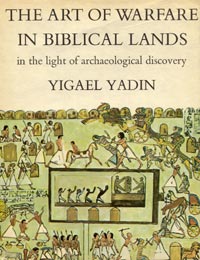
There is a stone carving of a wagon on a lintel at a late second to early third century synagogue at Capernaum that may be a picture of the Ark of the Covenant (See Harper's Bible Dictionary, 64).

Dr. Ralph Wilson thinks the Ark of the Covenant is actually a throne chair for God (I Samuel 4:4). He has pictures of what cherubim probably look like at Near Eastern Thrones and the Ark of the Covenant.
There are several carvings of what seems to be cherubim that have been found (BAR 21:4, pp.36-41). See Below:
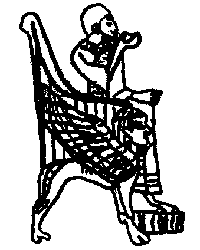 |
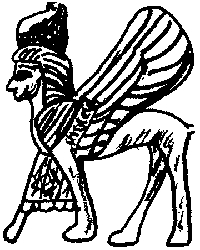 |
|
Cherub throne
|
Cherub ivory
|
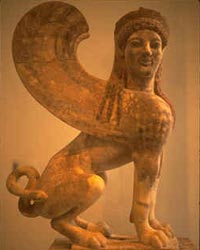 |
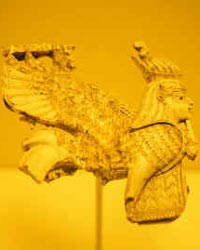 |
|
Cherub? Metro
|
Ivory Cherub? U of Penn.
|
Ritmeyer believes the Ark of the Covenant sat on the large rock under the Dome of the Rock on the Temple Mount. There is a rectangle carved into the rock that supposedly matches the measurements of the Ark, but this is questionable. See Where has the lost Ark of the Covenant been?
The exact description on how to build the Ark is in Exodus 25:10-22:
Have them make a chest of acacia wood-two and a half cubits long, a cubit and a half wide, and a cubit and a half high. (Note m: 3 ¾ feet long by 2 ¼ feet wide and high.) Overlay it with pure gold, both inside and out, and make a gold molding around it. Cast four gold rings for it and fasten them to its four feet, with two rings on one side and two rings on the other. Then make poles of acacia wood and overlay them with gold. Insert the poles into the rings on the sides of the chest to carry it. The poles are to remain in the rings of this ark; they are not to be removed. Then put in the ark the Testimony, which I will give you.
Make an atonement cover of pure gold-two and half cubits long and a cubit and a half wide. And make two cherubim out of hammered gold at the ends of the cover. Make one cherub on one end and the second cherub on the other; make the cherubim of one piece with the cover, at the two ends. The cherubim are to have their wings spread upward, overshadowing the cover with them. The cherubim are to face each other. Looking toward the cover. Place the cover on top of the ark and put in the ark the Testimony, which I will give you. There, above the cover between the two cherubim that are over the ark of the Testimony, I will meet with you and give you all my commands for the Israelites" (NIV).
Conclusion
There may have been several replicas of the Ark of the Covenant made. We do not know for sure where the real Ark of the Covenant is.
